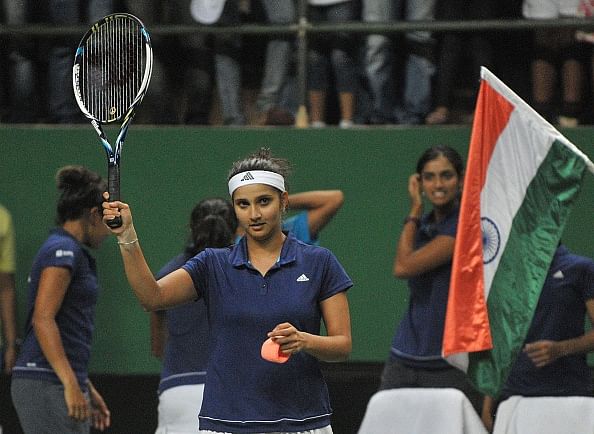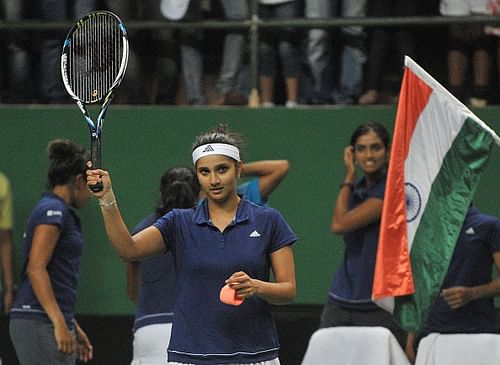
Sania Mirza's success overshadows lack of depth in Indian women's tennis

Sania Mirza is carrying Indian hopes alone
For the past one week, the entire country and the tennis world has been celebrating the rise of Sania Mirza to the top of the world doubles rankings. And why not? Mirza is the first Indian woman to climb to No. 1 in any tennis discipline and cements her place in tennis history permanently.
The 28-year-old Hyderabadi has been a trailblazer in Indian sport ever since she burst on to the consciousness of the Indian public and tennis world in 2005 trading blows with Serena Williams at the Australian Open.
But the question still beckons. What after Sania? Or rather who after Sania? Mirza’s rise, fall and rise back up the tennis world has not been accompanied by what many hoped would be a flurry of Indian talent on the international women’s tennis circuit. After Sania, you need to go down to the 200s to see the next ranked Indian player. India currently has 22 women in the WTA world rankings singles list, with 15 of them ranking inside the Top 1000 but only 2 inside the Top 500 – 22-year-old Ankita Raina ranked No. 248 and 21-year-old Prarthana Thombare ranked No. 488 in the world.
Indian players are struggling to make it to top WTA events
Comparatively, Li Na’s success on the Grand Slam stage twice over has led to a bigger explosion of Chinese talent on the WTA Tour – with 11 Chinese players ranking inside the Top 200. It’s not hard to figure out why. China has a world-class government-backed tennis programme with state-of-the-art facilities and coaching, besides several opportunities to earn valuable WTA ranking points – the country will hold as many as 10 WTA events this year.
India, which used to hold 2 WTA events in the years following Sania’s rise in the game, now holds none though there has been an increase in the number of ITF events held here. Back in 2005, there were 8 ITF events for the women, 7 of them in the $10K category and one in the $25K category. In 2014, there were 12 events held, 6 of them in the $10K category, 1 in the $15K category, 4 in the $25K category and 1 in the $50K category. The higher the prize money, the higher the ranking points on offer, but the tougher the quality of opposition as well.
Both Raina and Thombare have yet to play a WTA Tour event and continue to grind it out on the ITF circuit. Raina, India’s top-ranked player currently, has won 5 ITF singles titles and has now graduated from the $10K level to the $25K/ $50K level ITF level where the wins don’t come by as easily. While she is currently sitting close to a career-high ranking, her game is based more on her counterpunching abilities and she lacks a major weapon like Sania’s blistering forehand. If she does make it into the Top 100, it would be purely based on her grit and determination.
Tennis is an expensive sport
Besides training and coaching facilities, financial sponsorship continues to be another reason why our girls lag behind. Sponsors are hard to come by in a country where sporting dollars are still dominated by cricket; and tennis now has to compete with a host of other sports including badminton, golf, hockey, football and kabaddi to attract sponsors. And while Sania may earn up to 1 crore for endorsing a brand, the players down the ranks find it hard enough to make ends meet, while travelling on the international circuit – forcing several of them to quit the sport after struggling for a few years on the lower-levels of the circuit. Several others don’t even make it that far as the cost of training and grooming a youngster in tennis can be prohibitively expensive.
Young guns to look forward to
Still, there remains some hope for Indian women’s tennis. A few youngsters have made strides in recent times. 18-year-olds Snehadevi Reddy and Dhruthi Venugopal Tatachar are currently ranked No. 775 and No. 804 respectively and 16-year-old Karman Thandi is ranked No. 874 in the world. Thandi made a name for herself when she won the WTA Future Stars Invitational event in Singapore in October, played alongside the WTA Tour’s Year-End Championships where Sania won the biggest title of her career with Cara Black. But these girls still lag far behind their global contemporaries. 18-year-olds Belinda Bencic, of Switzerland, and Ana Konjuh, of Croatia, are already ranked inside the Top 100 in the world.
Learn from experienced players
There needs to be a concerted effort to help the Indian girls make a bigger impact on the international stage. Government aid and private sponsorship along with improved training and coaching facilities will go a long way in helping the next generation of players take a bigger step forward. One can only hope though that the spark that Sania has provided does not die down if another player does not make a significant impact by the time she retires.
As former Wimbledon champion Goran Ivanisevic commented during his recent trip to India, “You need a big player, a top 10 player, who is going to make the game popular and by seeing him/her, more kids take up the game.” But the Croatian did say that he is more impressed with the Indian girls as compared to the Indian boys. “From what I see, I like the girls more than guys. I don't mean guys are bad, but the girls are more talented.”
Ivanisevic fulfilled his destiny just about when no one expected him to. Let’s hope now that one of the young Indian girls look towards him and Sania for inspiration to break into the big time.